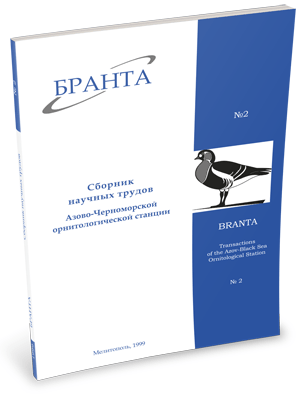
Transactions
of the Azov-Black Sea Ornithological Station



Breeding-site fidelity and colony formation in the Great Black-headed Gull
Kharitonov S. P.
The main study was carried out in April-early May of 1989-1982 at the Koyanly Islands (45.56 N, 34.56 E), the Eastern Sivash, the Sea of Azov, the Southern Ukraine. Some data collected in 1995 and 1999 at Koyanly Islands, Chongar and Kitay Islands were also involved. The total number of breeding Great Black-headed Gulls in 1989 on Koyanly Islands comprised 197 pair (5 colonies, from 4 to 11 nest), in 1990-238 pairs (2 colonies, 207 and 31 pairs). In 1991 Koyanly Islands held a single colony of 50 nests+ one single nest. The colony on Chongar Islands in 1991 contained about 200 nests. In 1992 Koyanly Island held a single colony of 65 nests, Chongar – about 175 nests. In 1995 a colony at Koyanly Islands contained 22 nests, Chongar – 45 nests, Kitay Island – 300 nests. In 1999 the only colony of 420 nests was found at Kitay Island.
In 1989 and 1990, fifty-eight adult birds were caught on their nests using alfa-chloralose. All of them were tagged. They gave a total of 461 field sightings. In the length of the four seasons 22 gulls were recorded during 2 successive seasons, 12 gulls during 3 seasons, 1 gull was noticed in all 4 seasons.
We found no case where a bird nested exactly on the same nest site during two or more successive years. The data of 35 resettlements between years show that there is almost no site fidelity within one colony or a group of colonies located nearby. Within this area the gulls choose nesting sites accidentally. However, within a larger territory (several dozens km) the Great Black-headed Gulls demonstrate a reliably site fidelity to a certain island or a group of close islands. There was no difference in nest-site fidelity of males and females. Successful hatching has some positive impact on nest-site fidelity but this impact is week and insignificant.
The colony formation was traced through the hatching sequence. At the earlier stages of colony formation, nest distributon was mostly random with the trend to be grouped, and finally in large colonies the distribution becomes uniform. Smaller colonies presumably stop to form at some early stage. Direct observations show that new settlers arrived in colony in already formed pairs, and choose their nesting site accidentally. Since the nest-site choice in the Great Black-headed Gulls within a colony or nearby colonies is mostly random, and colonies of this species have no visible macrostructure we can consider the colony structure of this species as more primitive one that in many other colonial species. The Great Black-headed Gulls easily form temporal small colonies and even single nests.
Special efforts were aimed at revealing group adherence. During four seasons of the main study I observed 17 cases when marking birds were neighbours. Mostly, there were pairs of nests, but large groups of neighbours up to 6 pairs were also registered. However, in 19 cases they disintegrated as easily as they formed. Most likely, the group adherence in this species is absent. If it, nevertheless, exists, it occurs in very little extent.
Read the paper in a PDF file